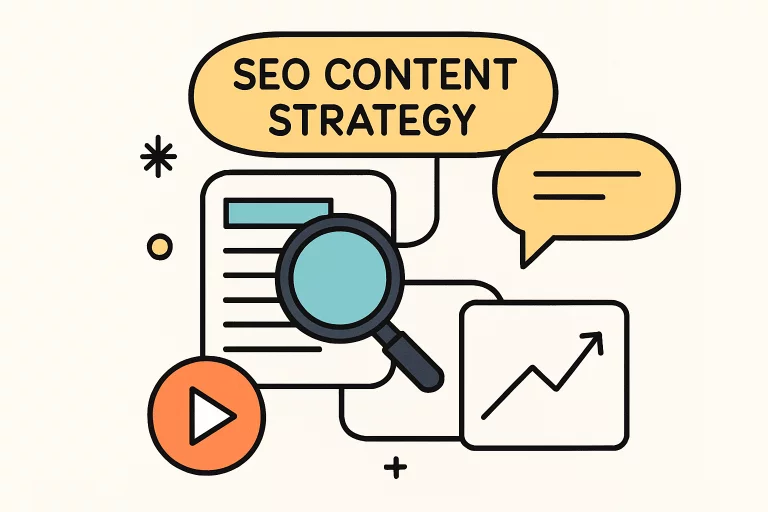Table of Contents
- Understanding Your Audience
- Crafting High-Quality Content
- Leveraging Multimedia Elements
- Optimizing for Search Intent
- Incorporating Interactive Elements
- Strategic Internal and External Linking
- Promoting Content Across Channels
- Analyzing and Adapting Strategies
In an increasingly competitive digital landscape, businesses must go far beyond the basics of optimization if they want to connect with their target audiences truly. Simple keyword insertion and on-page tweaks are no longer sufficient; to outpace competitors, brands must invest in sophisticated SEO content writing services that bridge the gap between achieving high search rankings and building authentic connections with readers. By thoughtfully combining proven strategy, engaging and audience-focused writing, and robust content promotion, businesses can nurture lasting online relationships that drive real value, far beyond just ranking well.
Mastering SEO content strategies is about much more than stuffing articles with keywords. It’s about fostering trust and delivering meaningful value, motivating users to return, share, and convert repeatedly. The following comprehensive guide breaks down actionable tactics designed to help you elevate your content marketing game and drive the kind of engagement that makes a real business impact.
Understanding Your Audience
High-performing SEO content always begins with a nuanced and thorough understanding of your target audience. Utilize robust analytics platforms to analyze audience demographics, behavior, and preferences, which involves examining factors such as age, gender, location, device usage, and browsing habits. Leverage insights from website analytics tools and social media metrics to develop highly accurate buyer personas—representations of your ideal customers that help you create content tailored to their unique needs. Additionally, active methods such as surveys, user polls, and one-on-one interviews are invaluable for uncovering pain points, content preferences, and emerging trends within your target market. By grounding your content strategy in real user data, you not only boost content relevance and engagement but also set the stage for higher trust and loyalty from your audience from the very beginning.
Crafting High-Quality Content
Quality is paramount when it comes to SEO content that drives engagement and delivers value. Invest ample time in thorough research and rigorous fact-checking to boost your content’s credibility and establish yourself as an authority in your niche. The content you produce should aim to answer every potential user query in detail, ensuring that readers leave your site satisfied, without needing to look elsewhere for information. According to Search Engine Journal, high-quality content should be accurate, original, and crafted with user intent in mind to effectively rank and resonate. Prioritize clarity and readability by using concise paragraphs, bullet points, and subheadings that are both descriptive and SEO-friendly. Weaving storytelling elements and case studies into your writing infuses personality and helps readers relate to your brand. Offering unique perspectives, original analysis, and actionable advice distinguishes your content from the competition, making your site a go-to resource within your industry. Ultimately, content that is well-structured, reliable, and insightful encourages more extended visits and repeat engagement, sending positive signals to both your audience and search engines.
Leveraging Multimedia Elements
Integrating a variety of multimedia elements significantly enhances content engagement and user retention. Visuals, such as crisp images, custom infographics, explainer videos, and illustrative graphics, serve multiple vital purposes: they break up long blocks of text, improve comprehension of complex ideas, and appeal to both visual and auditory learners. Research consistently shows that blog posts enhanced with images receive up to 94% more views than their text-only counterparts, underlining the critical role of visual content in boosting traffic. Embedding relevant and high-quality videos on your pages can also significantly increase user dwell time, a crucial metric for both SEO and user satisfaction. Supplement your articles with annotated screenshots for guides, data visualizations for analytical content, and short clips for quick tips or case studies. Always ensure that images and videos are compressed for faster loading, and don’t forget to add descriptive alt text, which aids both accessibility and SEO by making your content discoverable to a broader audience.
Optimizing for Search Intent
Aligning content with search intent is foundational to modern SEO success. It’s not enough to know which keywords are popular; you must also understand why searchers use them. Search intent can range from informational queries (e.g., “what is SEO?”) to navigational searches (e.g., “best SEO tools 2024”) to transactional searches (e.g., “hire SEO expert”). By tailoring your content type—whether it’s a how-to article, a product comparison, or a service landing page—and tone to fit the underlying intent, you significantly improve your chances of satisfying both users and the search engines. Utilize advanced keyword research tools, such as the Ahrefs Keyword Research Guide, to uncover relevant opportunities within your niche and pinpoint the questions and problems your audience is trying to solve. Incorporate target keywords naturally throughout titles, headers, metadata, and body text, while maintaining a reader-first approach. Forcing language can ultimately damage engagement and trust.
Incorporating Interactive Elements
Adding interactive content elements transforms your website from a passive information hub into a dynamic platform for user participation and engagement. Tools such as quizzes, polls, clickable infographics, and embedded calculators can increase on-page time, keep visitors engaged, and even generate valuable insights into individual user preferences. For example, implementing a quiz like “Which SEO Strategy Fits Your Business?” not only offers personalized value to users but also helps you collect actionable feedback that can refine your strategy. Interactive tables, accordions, and quick surveys organize content for easy browsing, streamlining navigation and enhancing the overall experience. These features actively engage readers, making your content more memorable and increasing the likelihood of return visits and social shares, ultimately creating a loyal audience base.
Strategic Internal and External Linking
Thoughtful linking is a hallmark of engaging, informative content that performs well in search engines. Incorporate internal links to guide readers to other relevant resources or cornerstone content within your website, whether it’s related blog posts, detailed product/service pages, or downloadable guides. This practice keeps visitors navigating through your site, increases session duration, and spreads link equity to help boost essential pages in search results. External links, primarily to leading industry resources and reputable studies, lend added credibility to your content and demonstrate that your research is thorough and reliable. For instance, referencing respected statistics or linking to in-depth guides from leading organizations increases the authority and trustworthiness of your pages. Consistently audit and update your internal and external links to ensure all resources are fresh, current, and direct users to the most accurate and up-to-date information available.
Promoting Content Across Channels
Creating quality content is only half the battle; a practical, multi-channel promotional plan is critical to ensure your work reaches the right audience. Share your content systematically across major social media platforms, tailoring the message and post format for each channel to maximize visibility and engagement. Tap into industry forums, online groups, content syndication platforms, and niche communities to distribute your content organically. Deploy targeted email newsletters to keep your most engaged audience updated and drive repeat traffic to your blog or resource hub. You can also expand your reach by encouraging employees, partners, and existing customers to share articles within their professional and social networks. Don’t overlook content repurposing—turn long-form articles into podcasts, short video explainers, infographics, or carousels to meet diverse user preferences and extend the life cycle of your original material. Ultimately, continued promotion is key to sustaining momentum and driving a steady influx of new visitors.
Analyzing and Adapting Strategies
Measuring the right data points is essential to understand what works—and what doesn’t—across your SEO content efforts. Define key metrics from the outset, such as organic search traffic, bounce rates, time on page, conversions, and even scroll depth or social shares, to gain a comprehensive view of performance. Utilize data-driven platforms like Google Analytics and Google Search Console to monitor trends, identify top-performing topics, track emerging keywords, and pinpoint pages with high exit rates. Regular, objective reviews of your analytics reports enable you to continuously refine your content mix and promotional strategy, focusing on tactics that yield results while adjusting or replacing those that underperform. This iterative, data-informed approach ensures you adapt to shifts in user behavior, evolving search algorithms, and competitor movements, positioning your brand to maintain and grow audience engagement for the long term.
When these SEO content strategies are implemented with careful intention and consistent effort, the results extend far beyond search engine rankings. Not only do they enhance organic visibility, but they also foster a deeper, more meaningful level of online engagement and loyalty, laying a solid foundation for sustainable digital growth and lasting brand impact.



